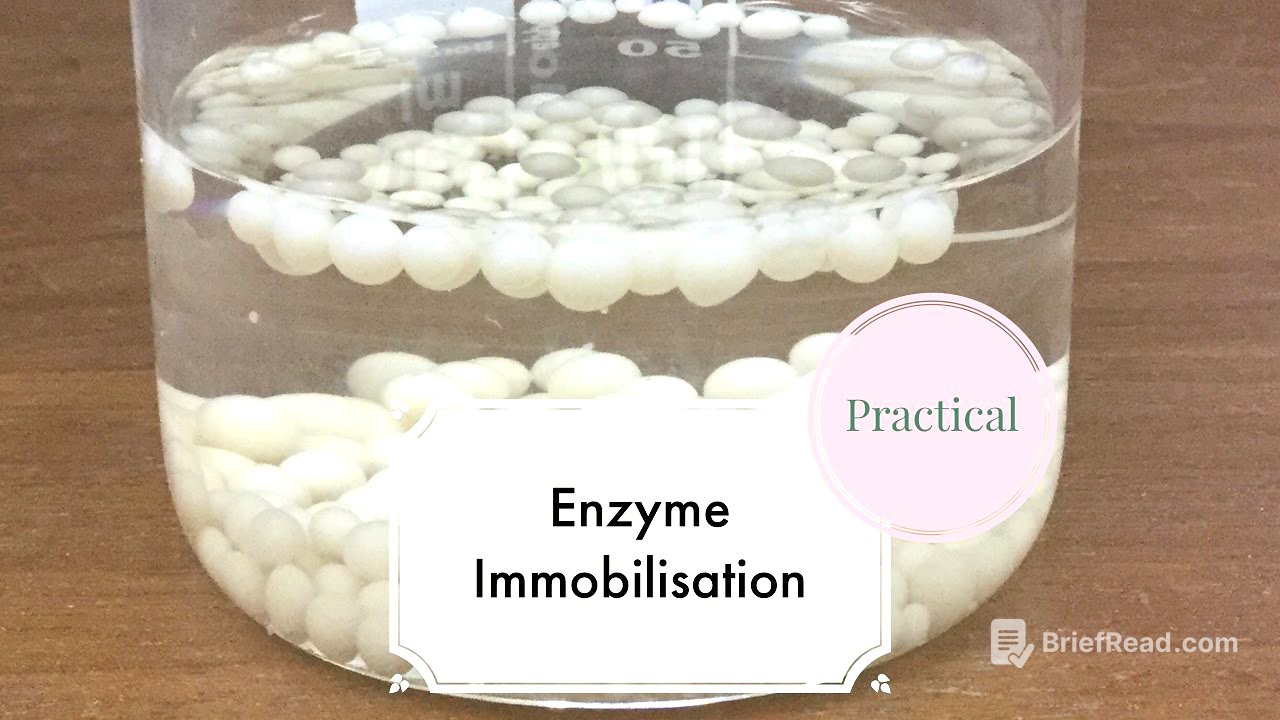TLDR;
This video explains enzyme immobilization, focusing on a practical example using yeast cells (containing the enzyme sucrase) trapped in a sodium alginate gel. It covers the immobilization process, testing the application of the immobilized enzyme, comparing it to a control (free yeast), and discussing the advantages of enzyme immobilization. The video also provides real-world examples of enzymes in use, such as pectinase and glucose isomerase.
- Enzyme immobilization involves fixing enzymes to each other or an inert material.
- Trapping enzymes in a gel (like sodium alginate) is a common immobilization method.
- Immobilized enzymes offer advantages like stability, reusability, and purer products.
Introduction to Enzyme Immobilization [0:00]
The video introduces enzymes as biological catalysts, specifically focusing on sucrase found in yeast cells. Sucrase acts on sucrose (the substrate) to produce glucose (the product). The practical demonstration involves immobilizing yeast cells to study the application of the enzyme.
The Process of Yeast Cell Immobilization [0:30]
Enzyme immobilization is defined as fixing enzymes to each other or to an inert material. In this experiment, yeast cells are immobilized by trapping them in a sodium alginate gel. The gel is prepared by mixing sodium alginate and distilled water, while the yeast is mixed separately with distilled water. The yeast solution is then added to the sodium alginate gel and mixed thoroughly. This mixture is drawn into a syringe and slowly dropped into a calcium chloride solution, forming beads. The calcium chloride hardens the beads, trapping the yeast cells within the alginate gel. The beads are left to harden for 10 minutes and then washed with distilled water to remove any free yeast cells from the surface.
Alternative Immobilization Methods [2:06]
Besides trapping in a gel, other immobilization methods exist. Physical methods include attaching enzymes to ceramic beads. Chemical methods involve bonding enzymes to physical supports or to each other.
Testing the Application of Immobilized Enzymes [2:28]
To test the application of the immobilized enzyme, the beads are transferred to a separating funnel with a straw to prevent clogging. Sucrose solution (the substrate) is added, and the solution is tested for glucose using glucose test strips every 2 minutes until a positive result is obtained.
Control Experiment: Free Yeast [3:00]
A control experiment is conducted using free yeast in a separating funnel with sucrose solution. The solution is tested immediately and every 2 minutes for glucose until a positive result is obtained, allowing for a comparison with the immobilized yeast.
Results and Comparison [3:16]
The results show that it takes longer for the immobilized yeast to produce a positive glucose result compared to the free yeast. This is because the sucrose has to diffuse through the pores of the gel to reach the yeast cells, and the product has to diffuse out. However, the product from the immobilized yeast is much clearer than the product from the free yeast, which is mixed with yeast cells.
Advantages of Enzyme Immobilization [3:48]
The advantages of enzyme immobilization include stabilizing the enzyme, allowing for reuse of the enzymes, and obtaining a purer product that does not require extensive purification.
Examples of Enzymes in Use [4:05]
Pectinase is used in food processing to extract and clarify fruit juices. Glucose isomerase is used in industry to convert glucose to fructose, reducing the need to add more sugar to products.
Conclusion [4:32]
The practical demonstration of enzyme immobilization ties into broader topics such as bioprocessing, single-cell proteins, and bioreactors.
